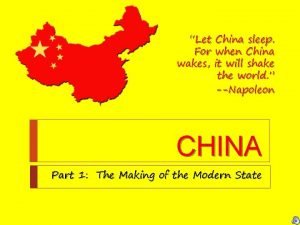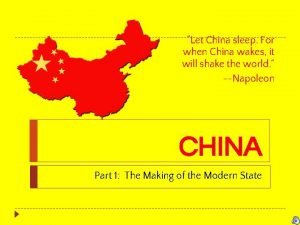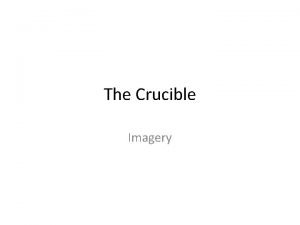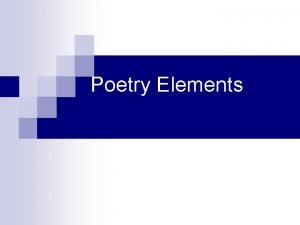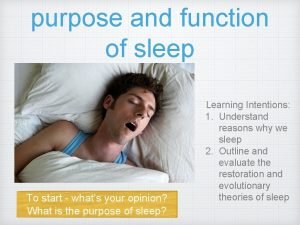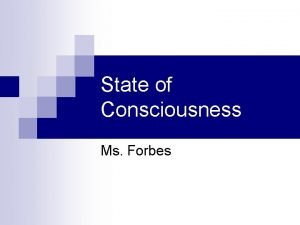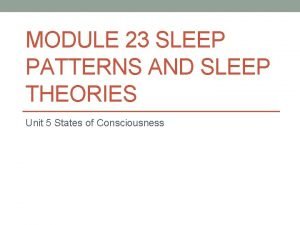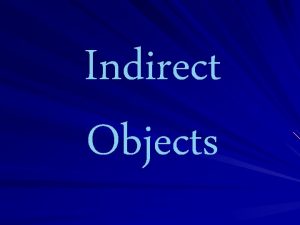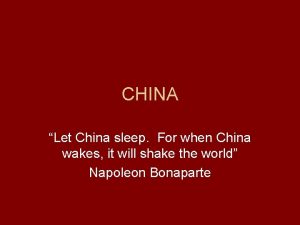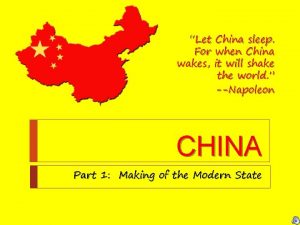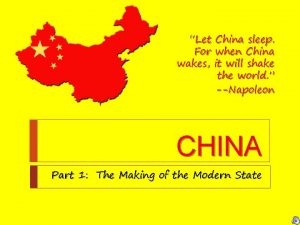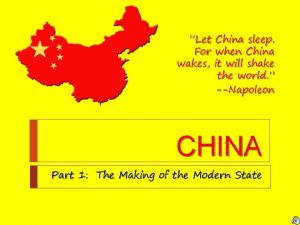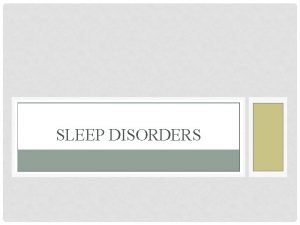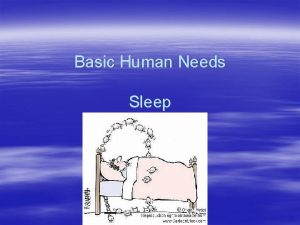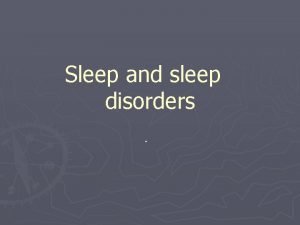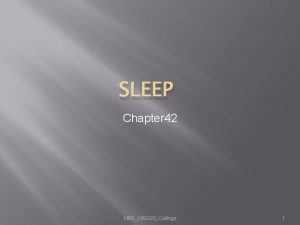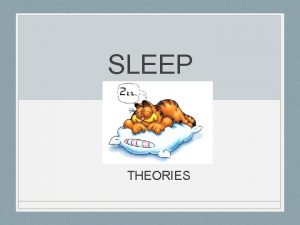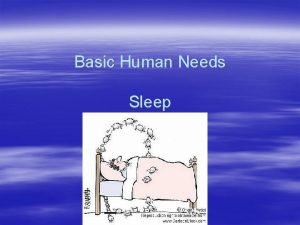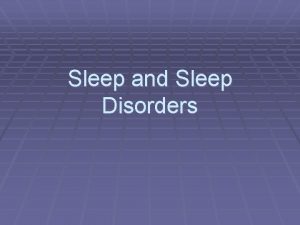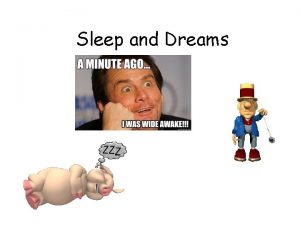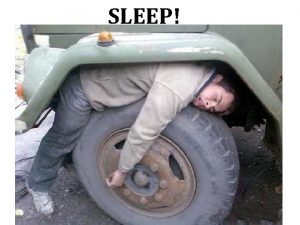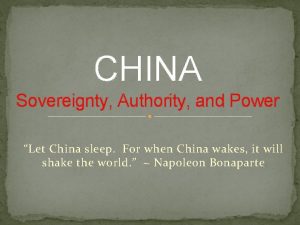Let China sleep For when China wakes it























- Slides: 23

“Let China sleep. For when China wakes, it will shake the world. ” --Napoleon CHINA Part 1: The Making of the Modern State

Why do we study China? � Unique history greatly shapes political culture � One of the few remaining communist nations � Successful move towards capitalism BUT remains highly authoritarian � Questions to ponder… � Will democratization follow economic reform success? � Will human rights violations keep China from global partnerships? � What type of change (if any) will Xi Jinping bring?

Geography Basics � Officially, the People’s Republic of China (PRC) � 4 th largest country � 9, 596, 961 sq mi � Less than 15% of land good for agriculture � Largest � 1. 3 population billion � *23 provinces � 5 autonomous regions � 4 centrally administered cities � 2 Special Administrative Regions (SAR)

Critical Junctures: Confucius � Imperial China (2000 years) & Confucianism � Harmony, order, and peace � Five duties of universal obligation basic human relations � Obedience to Authority, Hierarchy, Meritocracy � Civil service was created � Had to pass exams based on Confucian ethics � Ethnocentrism or

Critical Junctures: Confucius � Discussion Question: What elements of Confucianism do you think can be found in modern Chinese political culture?

Critical Junctures: Confucius � Discussion Question: What elements of Confucianism do you think can be found in modern Chinese political culture? �Obedience to authority – acceptance of authoritarian rule �Hierarchy – structure of the CCP

Critical Junctures: The Republic of China � 1839 -1949: Century of Humiliation � Economic stagnation/poverty � Increased pressure from the outside/imperialism � Dynastic rule ends � Nationalism rises � Revolution! (1911 -12) Establishes Republic of China � Sun Yat-sen became President � Believed in nationalism, democracy, & social welfare � Could not hold power � Warlords rule Sun Yat-sen Father of the Republic Father of the Revolution

Critical Junctures: The Republic of China � 1911 – 1949 Two political forces vie for power: � The Nationalist Party (KMT) � Led by Sun Yat-Sen � Focused on resisting foreign influence � Favored modernization and reform � Eventually led by Chiang Kai-Shek � Chinese Communist Party (CCP, founded 1921) � Led by Mao Zedong � By 1928, the CCP was forced West out of the cities and into the countryside Chiang Kai-Shek Leader of Nationalist


Critical Junctures: The People’s Republic of China � 1934 -1935: The Long March � Mao & supporters flee from Nationalist forces & gain support in the countryside � 1941 -1945: World War II � Communists more successful against Japan � 1949: The People’s Liberation Army marches into Beijing unopposed, establishing the People’s Republic of China (PRC) � The Nationalists fled to Taiwan, where they established the Republic of China (ROC)

Critical Junctures: Maoism � Maoism – form of communism that believed in the strength of the peasant � Key Values: � Collectivism � Struggle and Activism � Egalitarianism � Self-Reliance � Mass Line: leaders would communicate their will/direction to people, but people would communicate through mass line their wisdoms to leaders

Critical Junctures: Maoism � The Soviet Model (1949 -1957): � Land Reform � Redistributed property from rich to poor and increased productivity in countryside � Civil Reform � Free people from Opium addiction � Enhanced women’s legal rights � Five-Year Plans � Nationalized industry � Collectivized agriculture � Private property eliminated

Critical Junctures: Maoism � Discussion Question: Compare how the Communist Party came to power in China with how it came to power in Russia – how was it different? � How was Maoism similar to Marxist-Leninism in the Soviet Union? Different?

Critical Junctures: Maoism � Discussion Question: Compare how the Communist Party came to power in China with how it came to power in Russia – how was it different? � China: Communists won popular support by defeating Japan in WWII and then defeating the Nationalists in a civil war and then established a communist state, the PRC, which replaced the republic of 1911 � Russia: Bolsheviks led a communist revolution & overthrew the czar � How was Maoism similar to Marxist-Leninism in the Soviet Union? Different? � Similar: Democratic Centralism (Communist Party best directs needs of the masses); collectivization; nationalized industry

Critical Junctures: Maoism � The Great Leap Forward (1958 -1966) � Wanted to free China from Soviet domination � Utopian effort to transform China into a radical egalitarian society � Reorganizes China into communes that would serve all basic social and economic functions � Backyard � Red furnaces vs. Expert � Failure - Famine

Critical Junctures: Maoism � The Cultural Revolution (1966 -1976) � Goal – remove all vestiges of “old” China and its inequality � Scholars sent to fields to work � Universities/libraries destroyed � Emphasis on elementary education only � Student radicals (Red Guard) lead a purging of “class enemies”

Critical Junctures: Maoism � 1976: Mao dies leaving followers divided into factions � Radicals – led by Mao’s wife �One of the “Gang of Four” who supported radical goals of cultural revolution � Military � Moderates – moderates who emphasized economic modernization and some contact with other countries � Moderates win and arrest Gang of Four � Crash Course World History – China’s Revolutions

China in the 1980 s and 90 s… � 1980 Deng Xiaoping comes to power � Four Modernizations � 1. Agriculture � 2. Industry � 3. Science & technology � 4. Defense

Agriculture � Eliminated communes � Leased land to individual farmers � Farmers paid rent by delivering quotas of food to the government � Allowed to grow surplus and sell for profit � Food production increased 50% from 1978 -1984

Industry � Private businesses permitted to operate � Managers were given local control over state-owned factories � Managers could set production goals

Science and Defense � Allowed students to study abroad � Education focused on science and technology � Foreign investment was welcomed � Incomes increased, appliances purchased, western styles arrived � Tourism flourished

1989 Tiananmen Square

One China � Taiwan? � Hong Kong?
 Let china sleep for
Let china sleep for When china wakes up the world will shake
When china wakes up the world will shake Let me let me let me
Let me let me let me Grendel finally shows fear when
Grendel finally shows fear when Images from the crucible
Images from the crucible 2 elements of poetry
2 elements of poetry Module 23 sleep patterns and sleep theories
Module 23 sleep patterns and sleep theories Sidney compares sleep with
Sidney compares sleep with Module 23 sleep patterns and sleep theories
Module 23 sleep patterns and sleep theories Adults spend about ______% of their sleep in rem sleep.
Adults spend about ______% of their sleep in rem sleep. Module 16 sleep patterns and sleep theories
Module 16 sleep patterns and sleep theories America my home sweet home
America my home sweet home He who has ears to hear
He who has ears to hear Let's let them object to another one
Let's let them object to another one Teckenspråk minoritetsspråk argument
Teckenspråk minoritetsspråk argument Etik och ledarskap etisk kod för chefer
Etik och ledarskap etisk kod för chefer Datorkunskap för nybörjare
Datorkunskap för nybörjare Indikation för kejsarsnitt på moderns önskan
Indikation för kejsarsnitt på moderns önskan Ekologiskt fotavtryck
Ekologiskt fotavtryck Steg för steg rita
Steg för steg rita Shivaismen
Shivaismen Redogör för vad psykologi är
Redogör för vad psykologi är Claes martinsson
Claes martinsson Publik sektor
Publik sektor
